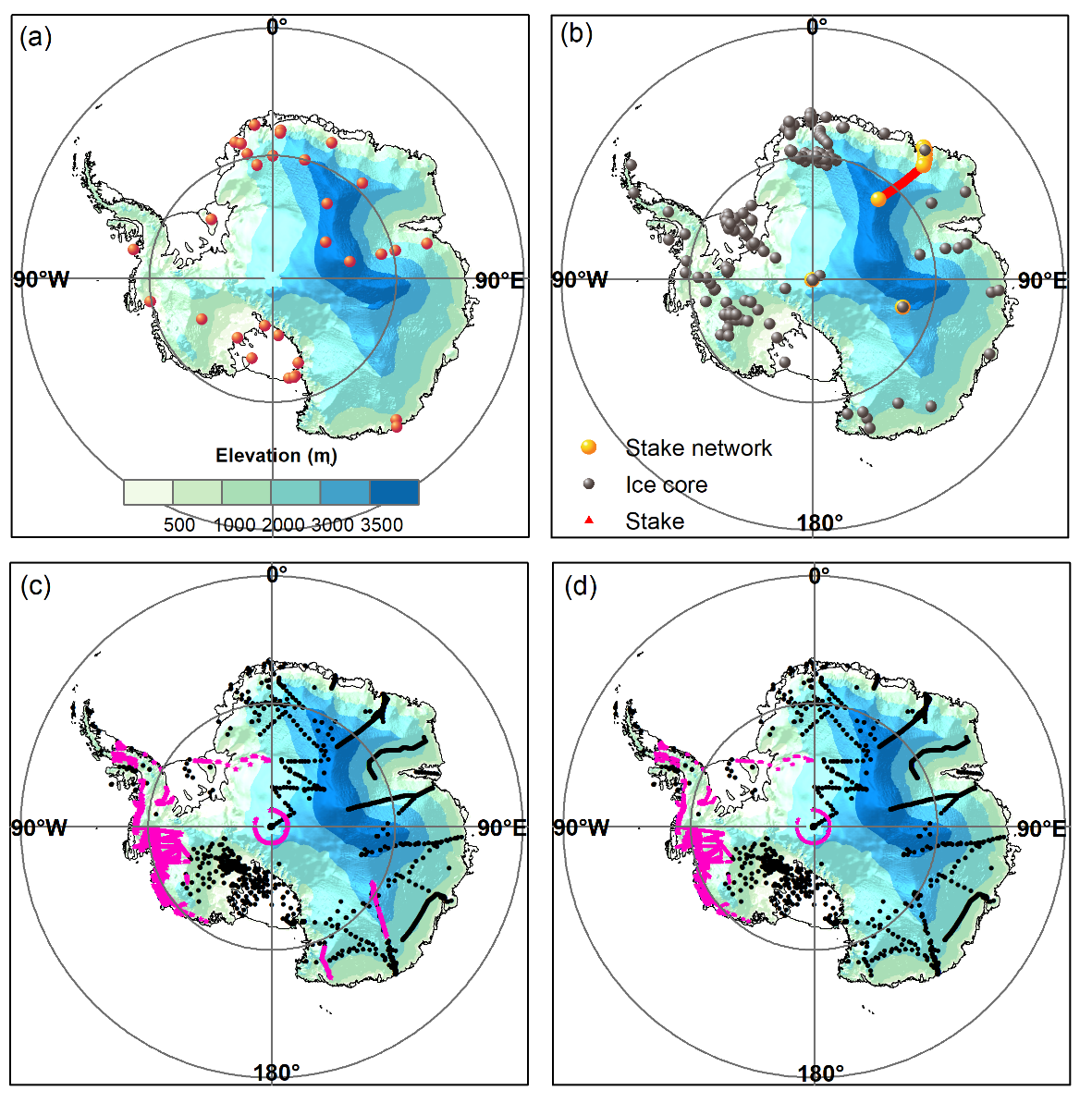-
A comprehensive dataset of surface mass balance field observations over the Antarctic Ice Sheet Published
Recently, Professor Wang Yetang (first author and corresponding author) from the College of Geography and Environment, Shandong Normal University and Professor XIAO Cunde (co-corresponding author) from the State Key Laboratory of Surface Processes and Resource Ecology, Beijing Normal University, together with researchers from the Chinese Academy of Meteorological Sciences, Shanghai Jiao Tong University, and the Institute of Oceanography and Atmospheric Research, Utrecht University, the Netherlands, published an article in Earth System Science Data (IF:11.33) entitled "The AntSMB dataset: a comprehensive compilation of surface mass balance field observations over the Antarctic Ice Sheet". The associated dataset is the most complete quality-controlled surface mass balance observations over the Antarctic Ice Sheet to date, with daily, annual, and multi-year averages in kgm-2yr-1, which has been published on the National Tibetan Plateau/Third Pole Environment Data Center (http://data.tpdc.ac.cn/en/) and openly accessible to users.

Figure 1. The comprehensive dataset of Antarctic SMB observations. (a) Spatial distribution of available AWS observations. (b) Locations of available annually resolved SMB observations. (c) Locations of available multi-year-averaged SMB field data. Purple five-pointed stars standard for GPR measurements. Black points represent reliable SMB determined by stakes/stake farms and ice cores/snow pits. (d) Location of multi-year-averaged SMB data only during the second half of the 20th century selected for model validation.
Against the background of rapid global warming, wide international concerns have arisen about changes in the Antarctic Ice Sheet (AIS) mass balance, which positively contributed 14.0 ± 2.0 mm to global sea level rise over 1979–2017 (Rignot et al., 2019). Antarctic mass balance is dependent on the partitioning between ice discharge into the ocean and net snow accumulation at the surface, i.e., surface mass balance (SMB). Recent negative mass balance of the ice sheet reflects larger ice dynamical loss than mass gain from SMB (e.g., Shepherd et al., 2012, 2018). Despite the responsibility of ice discharge for Antarctic mass balance on decadal or longer timescales, considerable inter-annual variability is largely determined by fluctuations in SMB (Rignot et al., 2019). Because annual net mass input into the entire ice sheet through snowfall is equivalent to about a 6 mm global sea level decline (IPCC, 2019), even any small fluctuations in the Antarctic SMB can result in large variability and trends in global sea level.
Antarctic Ice Sheet (AIS) instability is of great international concern in the context of increasing global warming. The surface mass balance is one of the four key processes affecting ice sheet instability, and any small change in it can have a significant impact on global sea level directly. Therefore, accurate estimation of the surface mass balance of the AIS is crucial to assess the changes in the AIS and its impact on sea level. Since the International Geophysical Year 1957–1958 (IGY), a number of scientific Antarctic traverses/expeditions have been performed with the goal of obtaining surface mass balance measurements by means of stakes, ice cores/snow pits, ultrasonic sounders, or ground-penetrating radar (GPR). However, the technical means of observing the surface mass balance of the ice sheet have their shortcomings, resulting in uneven quality of the observations, which becomes one of the bottlenecks limiting the accurate estimation of the surface mass balance of the AIS. Therefore, it is important to establish a reliable database of surface mass balance.
Through domestic and international cooperation, the observation data of ice core, snow pit, automatic weather station, stakes and ground-penetrating radar have been widely collected, especially the research results since the International Polar Year 2007-2009. Based on the verification and comparison analysis, the quality control standard of the AIS surface mass balance data was established by referring to the existing observation data quality control standard. The collected Antarctic mass balance dataset was strictly quality controlled and selected, and the most complete and quality controlled daily, annual and multi-year average AIS surface mass balance database was built so far. The most complete and quality-controlled database of daily, annual and multi-year average AIS surface mass balance has been completed to date. The database can be used for the assessment of the spatial and temporal variability of the surface mass balance in the Antarctic region, and is the basic information for the validation and calibration of climate models, reanalysis data and remote sensing inversion algorithms, as well as an important input data for the assimilation of paleoclimate data.
This work was supported by the Strategic Priority Research Program of the Chinese Academy of Sciences (grant no. XDA19070103), the National Natural Science Foundation of China (grant no. 41971081), the Project for Outstanding Youth Innovation Team in the Universities of Shandong Province (grant no. 2019KJH011), and the Outstanding Youth Fund of Shandong Provincial Universities (grant no. ZR2016JL030).
Article:
Wang, Y. T., Ding M. H., Reijmer, C. H., Smeets, P. C. J. P., Hou, S. G., and Xiao, C.D. The AntSMB dataset: a comprehensive compilation of surface mass balance field (2021). Earth Syst. Sci. Data, 13, 3057–3074, https://doi.org/10.5194/essd-13-3057-2021.
Data available at:

 Copyright ©right; 2017 - 中国科学院西北生态环境资源研究院 - 兰州数云软件科技有限公司提供技术支持
Copyright ©right; 2017 - 中国科学院西北生态环境资源研究院 - 兰州数云软件科技有限公司提供技术支持